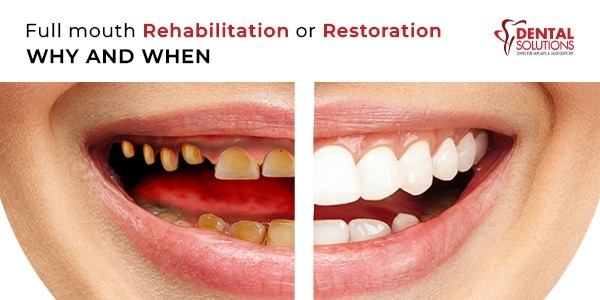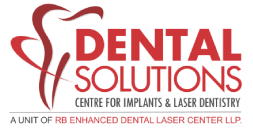Full Mouth Rehabilitation or Restoration – Why and When?

Full mouth rehabilitation or restorations: Does it sound like a complicated procedure to you? We are here to help you understand full-mouth rehabilitation in the simplest manner.
- What is full-mouth rehabilitation or restoration?
- Why and when is full-mouth rehabilitation recommended?
- Which are the most common treatments that are conducted under full-mouth rehabilitation?
- What is the process for full-mouth rehabilitation?
What is full mouth rehabilitation or restoration?
Full Mouth Rehabilitation is conducted when the majority of the teeth in a patient's mouth need restoration and correction. In this procedure, the entire mouth of the patient is taken care of, while also keeping major focus on the aesthetic front.
In other words, full-mouth restoration combines aesthetics with the practices of restorative dentistry to improve the health, function, and beauty of the mouth. A complete mouth restoration is a set of dental procedures that are tailored to the patient's specific needs. When reconstructing the mouth and restoring oral health, treatment options for jaw joints, bite, smile, and facial support are all taken into account.
Full-mouth rehabilitation can replace missing teeth, repair teeth alignment, fill in gaps, treat periodontal disease, improve any TMD symptoms, improve your smile, boost confidence, and more importantly improve your overall health.

Who is an ideal candidate for full mouth rehabilitation?
Patients with multiple dental issues are typically the ideal candidates for a full mouth restoration or rehabilitation.
- Excessive wear due to bruxism – resulting in cracked or fractured teeth.
- Gum disease
- Several missing teeth
- Bite misalignment
- Temporomandibular joint pain and severe deterioration
- Density loss in the jawbone
- Patients undergoing full mouth rehabilitation may require the replacement of previous dental restorations that have worn out over time.
Patients who are candidates for full mouth reconstruction should be in generally good health condition and have multiple oral health issues – majorly focusing on the above list.
Most common procedures conducted under full-mouth rehabilitation:
Onlays, crowns, bridges, veneers, dental implants, dentures, etc. are some of the procedures that are used. This not only gives the necessary smile makeover but also fixes the underlying dental issues and oral function as required.
- Inlays and Onlays to cover cavities
Inlays and Onlays are used when a tooth has experienced too much damage and cannot support a basic filling, but the damage is not extremely extensive that a crown is necessary. They are more substantial than fillings. An inlay is a dental restoration that fills cavities in the regions between the cusps of a tooth. An Onlay can work for a larger area, including the cusps, rather than only filling in cavities within those spaces. They function similarly to crowns, although they do not cover the entire tooth surface as a crown does. Porcelain or a composite material that is stronger and more durable than standard fillings is utilized for inlays and Onlays. These are more expensive than a traditional filling, but they last longer.
- Dental Crowns to restore, or protect teeth
Dental crowns are caps that are placed on top of broken or decayed teeth. When fillings fail to solve the problem, crowns are utilized to preserve, cover, and restore the shape of your teeth. Metals, porcelain, resin, and ceramics are the different materials from which dental crowns are made. Dental crowns are very much suitable in situations where a weak tooth needs protection, restoring a broken tooth, covering a tooth that's been treated with a dental implant, and more.
- Dental Veneers to improve the appearance
Dental veneers may be an option for you to attain the look you want. They're a common solution for people who have chipped teeth, a gap between their teeth, or teeth that are misshaped.
Dental veneers are thin covers that are glued to the front of teeth to give them a more aesthetically formed appearance. They are tooth-coloured. Dental veneers are used when teeth are misaligned, uneven, irregularly shaped, or discoloured or teeth are showcasing gaps between them and more.
- Treatment of TMJ (Temporomandibular Joint)
Conducting Arthrocentesis which is a minimally invasive procedure or arthroscopic surgery – This is known to be effective for treating various types of TMJ disorders or open-joint surgery (arthrotomy) to repair or replace the joint.
- Dental Implants for full teeth replacement
Dental implants are artificial dental roots (metal, screwlike posts) that are used to replace missing teeth. Fixed (permanent) or removable replacement teeth that are created to match original teeth and are supported by implants.
What is the process for a full mouth rehabilitation procedure?
A dentist will not guarantee that your dental health will improve in only one visit. A whole mouth rehabilitation entails a number of different procedures. This is how the procedure is usually carried out:
Full mouth rehabilitation steps: First, the dentist will examine the current tooth and the overall oral health. X-rays and lab diagnostics will help determine what needs to be fixed and how each tooth is currently positioned. This will most likely take one full appointment. Depending on your dental problems, your dentist will devise a treatment plan for you and assist you in reshaping your bite, fixing your cracked tooth, fixing cavities and alike. Of course, when our dental professionals start with the diagnosis, we first make sure to check if your oral issues can be fixed using minimal methods, for example, if we discover that your mouth can be fixed solely through individual tooth restoration, we will go ahead with it.
Once the treatment plan is ready, a full-mouth scan or, in some situations, impressions will be taken in order to ensure that each individual tooth receives the attention it requires. Temporary restorations may be supplied if necessary, while the impressions are used to create your permanent restorations.

Additionally, a very important point to note in full mouth rehabilitation is that – the vertical dimension (the distance between two chosen points on the face above and below the mouth when the teeth are in occlusion) will need to be increased to avoid TMJ issues. Changes in vertical dimension can allow for more conservative dental rehabilitations.
A full mouth reconstruction can help protect your oral health by effectively treating a variety of disorders such as tooth decay, gum disease, tooth loss, and severely damaged teeth, all at once. At Dental Solutions, Bangalore, we can restore the shine and sparkle of your smile using professional and the latest dental technologies. Contact us to schedule your no-obligation consultation to know more about the advantages of full mouth rehabilitation and full mouth rehabilitation cost
